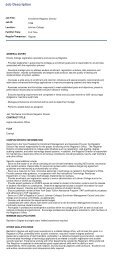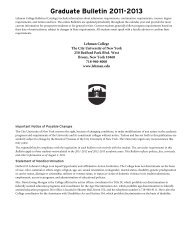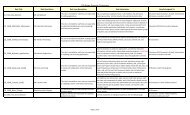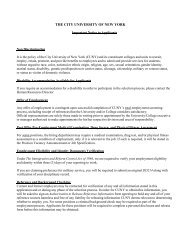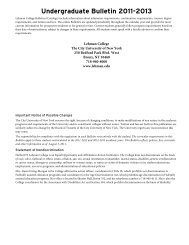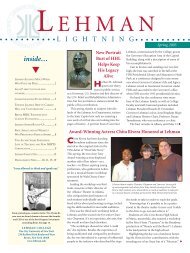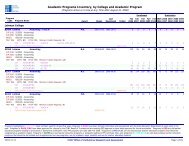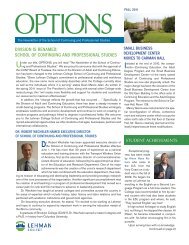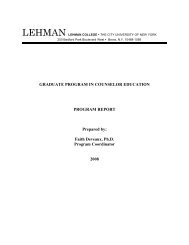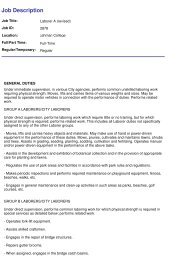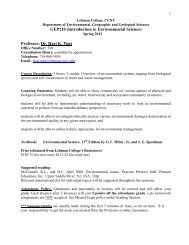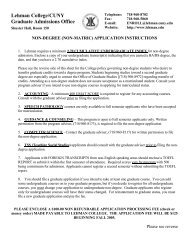Lehman Center Turns Thirty - Lehman College
Lehman Center Turns Thirty - Lehman College
Lehman Center Turns Thirty - Lehman College
Create successful ePaper yourself
Turn your PDF publications into a flip-book with our unique Google optimized e-Paper software.
ookshelf<br />
Nonsense on Stilts: How to Tell<br />
Science from Bunk<br />
(University of Chicago Press, 2010). Massimo Pigliucci.<br />
Massimo Pigliucci isn’t your typical professor.<br />
For starters, the chair of <strong>Lehman</strong>’s Philosophy<br />
Department has three doctorates—no, that’s<br />
not a typo; he has three doctorates. He began his professional<br />
career as a scientist and earned his fi rst pair of Ph.D.s in genetics<br />
and evolutionary biology.<br />
Well into his career as a biologist, after he had already attained<br />
tenure at the University of Tennessee, Knoxville, his work led him<br />
down the path of theoretical biology. It was then that his interest<br />
in philosophy, nurtured since his high school days in his native Italy,<br />
came to the forefront. “The leap from theoretical biology to philosophy<br />
is surprisingly brief,” he says.<br />
Fast-forward a few years: Dr. Pigliucci earns his third Ph.D., this<br />
one in philosophy, at the University of Tennessee and embarks on a<br />
new career, eventually moving in 2009 from SUNY at Stony Brook<br />
to his current position at <strong>Lehman</strong>.<br />
His work—and the subject of his latest book—seem to be infl uenced<br />
by the theory that British scientist and novelist C.P. Snow<br />
discussed in his 1959 essay “The Two Cultures.” Well versed in<br />
both the sciences and the humanities, Snow decried the fact that<br />
so many of his peers on both sides of the academic fence did not<br />
share his allegiance to the two disciplines. According to Snow, the<br />
fact that literary intellectuals likely know little about science, and<br />
Hispanics in the United States: A Demographic,<br />
Social, and Economic History, 1980 - 2005<br />
(Cambridge University Press, 2010). Laird W. Bergad.<br />
Hispanics in the United States have made signifi cant progress<br />
over the last twenty-fi ve years in their range of careers and levels<br />
of education and income, according to <strong>Lehman</strong> Distinguished<br />
Professor Laird W. Bergad, who has just completed the fi rst<br />
extensive study of this population since 1987.<br />
“Latinos are not much different from other immigrant<br />
groups that came to the U.S. in the past in many ways,”<br />
says Dr. Bergad. “Although they lag behind other race/<br />
ethnic groups in many social indicators, what we see<br />
is an impressive record of improvement.” He cites<br />
an increasing number of college graduates as one<br />
example—from eight percent of all adults in 1980 to<br />
fourteen percent in 2008—as well as rising household<br />
8 <strong>Lehman</strong> Today/Fall 2010 – Winter 2011<br />
that just as many scientists may never read Shakespeare,<br />
created a barrier of “two cultures.”<br />
“Each group doesn’t seem to think that knowledge of the other<br />
side, at least superfi cial knowledge, ought to be a part of anyone’s<br />
intellectual education,” says Dr. Pigliucci. “I fi nd<br />
that strange.”<br />
Nonsense on Stilts tries to bridge that gap. As the<br />
book’s opening pages point out, some, including<br />
scientists like Thomas Henry Huxley, believe that “we<br />
have a moral duty to distinguish sense from nonsense.”<br />
In Nonsense on Stilts and with remarkable clarity and<br />
precise—often-entertaining—prose, Dr. Pigliucci cites<br />
the danger of pseudoscientifi c ideas and theories that have captivated<br />
so much of the general public.<br />
“I agree with Huxley, and that’s a major reason why I wrote this<br />
book. Pseudoscience is not just an intellectual curiosity, it has<br />
ethical consequences. Literally, pseudoscience kills.”<br />
While Dr. Pigliucci takes on some less-harmful examples of pseudoscience,<br />
such as astrology—“It doesn’t work; we know it doesn’t<br />
work; it really is bunk,” he says—his main concerns are the dangerous<br />
impact of non-scientifi c beliefs, such as the far-too-prevalent<br />
concept of what he calls “AIDS Denialism.”<br />
“Some African countries, including some African governments,<br />
have bought into this idea that AIDS is not caused by H.I.V.,”<br />
he says, “and that it is a Western conspiracy of pharmaceutical<br />
companies and the C.I.A. It’s fairly popular in the United States as<br />
well. The result is that many people in these<br />
countries are not taking the drugs, and<br />
they’re dying.”<br />
income. Still, Latinos continue to have very high<br />
rates of poverty. A quarter of all Hispanics continue<br />
to live below the poverty line, about the same<br />
as in 1980.<br />
Dr. Bergad and his co-author, Professor Emeritus<br />
Herbert S. Klein of Columbia University, analyzed<br />
U.S. Census and other statistical data, emphasizing<br />
changes that have taken place within the Latino<br />
population over time. Their new book, Hispanics in the United<br />
States: A Demographic, Social, and Economic History, 1980 -<br />
2005, examines the basic patterns that led to the formation of this<br />
complex minority group, which is projected to comprise one-third of<br />
the total U.S. population by 2050.<br />
One of Dr. Pigliucci’s gifts as a writer is his willingness to take a<br />
strong stand. He doesn’t shy away from controversial topics like<br />
the “debates” over global warming and Intelligent Design or the<br />
role of supposedly impartial “think tanks” and their cozy relationship<br />
with the media. Nonsense on Stilts is a book that will force you to<br />
think and rethink. And then think again. <br />
The Circulatory Story<br />
(Charlesbridge Publishing, 2010). Mary K. Corcoran.<br />
When Mary K. Corcoran (B.A., ‘86) was an<br />
undergraduate at <strong>Lehman</strong>, she had no idea<br />
that she would become an author someday.<br />
Although she loved to write, she wasn’t an<br />
English or literature major. “I wrote a little bit<br />
in elementary school,” she says, “but I never<br />
thought about a writing career per se.”<br />
In fact, despite an early focus on music—while in high<br />
school, she sang in plays and performed summer stock<br />
in Westchester—and education, Corcoran eventually<br />
earned her degree in biology. “I actually started out<br />
as an environmental science major, then switched to<br />
music, and then fi nally to biology,” says the writer from<br />
her home in Redding, Conn.<br />
After graduation, she moved to Colorado, where she had volunteered<br />
during her undergrad years as a National Park Service<br />
Ranger giving summer tours. For the next seven years, she lived in<br />
Colorado Springs and taught earth science in middle school, while<br />
also enjoying the beauty of the Rockies and the natural grandeur<br />
of the State’s notable parks.<br />
“While other similar studies have presented static portraits of<br />
particular measures, we looked at how indicators like education,<br />
marriage patterns, wealth, and poverty have changed since 1980,”<br />
explains Dr. Bergad. The book provides an extensive database<br />
for researchers.<br />
Dr. Bergad, the founding director of the <strong>Center</strong> for Latin American,<br />
Caribbean, and Latino Studies at the CUNY Graduate <strong>Center</strong>, was<br />
named a Distinguished Professor of Latin American and Puerto<br />
Rican Studies in 2009, making him the seventh current member<br />
of the <strong>Lehman</strong> faculty to hold this rank. He has received numerous<br />
awards, including Guggenheim, Fulbright, and National Endowment<br />
for the Humanity fellowships. <br />
Her love of teaching combined with her passion for biology, which<br />
she witnessed fi rst-hand in the great outdoors of Colorado, and<br />
soon sparked a long-dormant interest in writing. “It all just kind of<br />
evolved,” she says. Soon she was freelancing for children’s magazines<br />
like Boys’ Quest and Hopscotch, penning poems and nature<br />
pieces geared at an audience as young as her own students.<br />
“I thought I would write a book of science-themed poetry for kids,”<br />
she remembers, but her publisher had different ideas. “I sent a<br />
poem to Charlesbridge Publishing, and they contacted me. They<br />
didn’t like the poem I wrote, but the editor asked me if I had<br />
anything else.”<br />
The result was The Quest to Digest, her fi rst book published by<br />
Charlesbridge in 2006. Her idea was to make the biological processes<br />
of the human digestive system—not the easiest scientifi c<br />
topic to discuss with children—a little more, well, palatable. “I take<br />
them on an adventure,” says Corcoran, “and try to make it fun.”<br />
She was so happy with the results—and her<br />
collaboration with illustrator Jeff Czekaj—<br />
that the pair teamed up again for a second<br />
work, The Circulatory Story, in which she<br />
explores the inner workings of the heart and<br />
circulatory system.<br />
Now, Corcoran, who no longer teaches fulltime,<br />
has launched her own business that<br />
combines all her passions: science, teaching, and writing. She gives<br />
talks and presentations to grade-school kids and makes author’s<br />
visits. “It’s all about making science fun and interesting for children,”<br />
she says.<br />
Learn more at www.tree-mendousscience.com. <br />
Attention, <strong>Lehman</strong> Alumni—<br />
Your Opinion Matters!<br />
Please help the Alumni Association and Alumni Offi ce design<br />
events and activities based on your preferences. We invite you to<br />
participate in the 2010 Alumni Survey. Visit www.lehman.edu and<br />
click on “Alumni & Friends” on the upper right-hand side. You will<br />
fi nd the link Alumni Survey 2010 in the listing. You can also type<br />
this link www.lehman.edu/alumni/alumni-survey.php directly into<br />
the address (URL) bar at the top of your browser. Your participation<br />
in this quick survey will enter you in a raffl e for various prizes,<br />
including gift cards to iTunes and Starbucks, with the top prize of<br />
a $100 VISA Gift Card. The Alumni Offi ce also has a new easyto-remember<br />
e-mail address for alumni: alumni@lehman.cuny.edu.<br />
<strong>Lehman</strong> Today/Fall 2010 – Winter 2011 9




